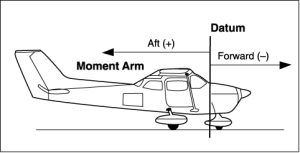Part of your preflight duties as a pilot will be to determine the weight and balance of the aircraft. Trying to takeoff and fly with an aircraft over max gross weight or out of balance can cause drastic consequences on the airplane’s ability to fly. Below are some of the terms that will be important to understand when conducting weight and balance computations.
Empty Weight—The weight of the airframe, engines, and all items of operating equipment that have fixed locations and are permanently installed in the aircraft. Empty weight includes optional and special equipment, fixed ballast, full reservoirs of hydraulic fluid, engine lubricating oil, and the unusable fuel, but does not include occupants, baggage, or cargo.
Useful Load—The difference between the maximum allowable weight of the aircraft and its empty weight. The useful load of an aircraft includes the weight of the fuel and oil, the crew, passengers, all of their baggage, and any cargo carried.
Takeoff Weight—The weight of an aircraft just before brake release. It is the ramp weight less the weight of the fuel burned during start and taxi.
Landing Weight—The maximum weight an aircraft is allowed to have for landing. Landings put far more stress into an aircraft structure than takeoffs, and therefore large aircraft that fly for long distances are allowed to have a greater weight for takeoff than for landing.
Datum—An imaginary vertical reference plane or line chosen by the aircraft manufacturer from which all arms used for weight and balance computation are measured.
Arm—The horizontal distance in inches between a reference datum line and the center of gravity of an object. If the object is behind the datum, the arm is positive, and if it is ahead of the datum, the arm is negative.
Moment—The product of the weight of an object multiplied by its arm expressed in pound-inches (lbs-in). A formula that is used to find moment is usually: Weight x Arm = Moment.

Moment Index—A moment divided by a constant, such as 10, 100, 1,000, or an even larger number. The use of a moment index allows weight and balance computations to be made using smaller numbers, decreasing the chance for errors.
Center of Gravity—The point at which an aircraft will balance, expressed in inches from datum. The center of gravity is found by dividing the total moment by the total weight: Total Moment / Total Weight = CG (inches aft of datum).
Standard Weight—Values used when specific weights are not available.
- General Aviation Crew and Passenger. 170lbs each.
- AvGas–6 lbs/U.S. gallon
- Turbine Engine Fuel–6.7 lbs/U.S. gallon
- Lubricating Oil–7.5 lbs/U.S. gallon
- Water–8.35 lbs/U.S. gallon
A question for you: if an aircraft is loaded 90 pounds over maximum certificated gross weight and fuel (AvGas) is drained to bring the aircraft weight within limits, how much fuel should be drained?




